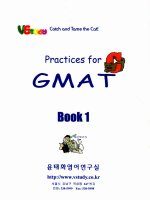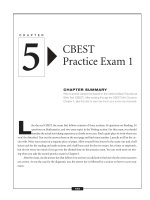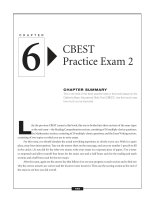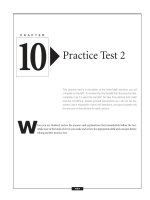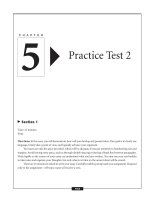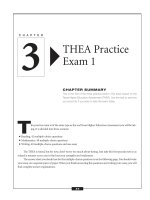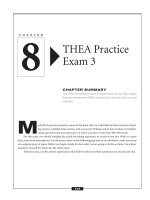THEA Practice Exam 2
Bạn đang xem bản rút gọn của tài liệu. Xem và tải ngay bản đầy đủ của tài liệu tại đây (264.66 KB, 42 trang )
L
ike the real THEA, the exam that follows is made up of three sections: a Reading section, a Mathe-
matics section, and a two-part Writing section that consists of multiple-choice questions and one
essay topic.
For this practice exam, you should simulate the actual test-taking experience as closely as you can. Find a
quiet place to work where you won’t be disturbed. You can use the answer sheet on the following page. You should
write your essay on a separate piece of paper. Allow yourself five hours for the entire exam. Don’t worry about
how long it takes to do each section. On the actual THEA, you may move from section to section as you please,
go back and forth between sections, or even decide to do only one section. Since you should decide beforehand
how many sections you will take and in what order, use this practice test to find out how you work best. Perhaps,
for example, you can do your writing sample first, while you are fresh.
After the exam, review the answer explanations to find out what questions you missed and why.
CHAPTER
THEA Practice
Exam 2
CHAPTER SUMMARY
Here is another practice test based on the Texas Higher Education
Assessment (THEA). After working through the review lessons in Chap-
ters 4, 5, and 6 take this test to see how much your score has
improved.
7
197
–
LEARNINGEXPRESS ANSWER SHEET
–
199
Answer Sheet
SECTION 1: READING SECTION 2: MATH SECTION 3: WRITING PART A
1. abcd
2. abcd
3. abcd
4. abcd
5. abcd
6. abcd
7. abcd
8. abcd
9. abcd
10. abcd
11. abcd
12. abcd
13. abcd
14. abcd
15. abcd
16. abcd
17. abcd
18. abcd
19. abcd
20. abcd
21. abcd
22. abcd
23. abcd
24. abcd
25. abcd
26. abcd
27. abcd
28. abcd
29. abcd
30. abcd
31. abcd
32. abcd
33. abcd
34. abcd
35. abcd
36. abcd
37. abcd
38. abcd
39. abcd
40. abcd
41. abcd
42. abcd
1. abcd
2. abcd
3. abcd
4. abcd
5. abcd
6. abcd
7. abcd
8. abcd
9. abcd
10. abcd
11. abcd
12. abcd
13. abcd
14. abcd
15. abcd
16. abcd
17. abcd
18. abcd
19. abcd
20. abcd
21. abcd
22. abcd
23. abcd
24. abcd
25. abcd
26. abcd
27. abcd
28. abcd
29. abcd
30. abcd
31. abcd
32. abcd
33. abcd
34. abcd
35. abcd
36. abcd
37. abcd
38. abcd
39. abcd
40. abcd
41. abcd
42. abcd
43. abcd
44. abcd
45. abcd
46. abcd
47. abcd
48. abcd
1. abcd
2. abcd
3. abcd
4. abcd
5. abcd
6. abcd
7. abcd
8. abcd
9. abcd
10. abcd
11. abcd
12. abcd
13. abcd
14. abcd
15. abcd
16. abcd
17. abcd
18. abcd
19. abcd
20. abcd
21. abcd
22. abcd
23. abcd
24. abcd
25. abcd
26. abcd
27. abcd
28. abcd
29. abcd
30. abcd
31. abcd
32. abcd
33. abcd
34. abcd
35. abcd
36. abcd
37. abcd
38. abcd
39. abcd
40. abcd
Section 1: Reading
Questions 1–6 are based on the following passage.
The following is taken from a case that came before the
Supreme Court in 1954: “347 US 483 (1954) Brown v.
Board of Education.”
(1) These cases come to us from the States of Kansas,
South Carolina, Virginia, and Delaware. . . . Argu-
ment was heard in the 1952 Term and reargument
was heard this Term on certain questions pro-
pounded by the Court.
(2) Reargument was largely devoted to the cir-
cumstances surrounding the adoption of the 14th
Amendment in 1868. It covered exhaustively con-
sideration of the Amendment in Congress, ratifica-
tion by the states, then existing practices in racial
segregation, and the views of proponents and oppo-
nents of the Amendment. These sources and our
own investigation convince us that, although these
sources cast some light, it is not enough to resolve
the problem with which we are faced. At best, they
are inconclusive. The most avid proponents of the
post-War Amendments undoubtedly intended them
to remove all legal distinctions among “all persons
born or naturalized in the United States.” Their
opponents, just as certainly, were antagonistic to
both the letter and the spirit of the Amendments and
wished them to have the most limited effect. What
others in Congress and the state legislatures had in
mind cannot be determined with any degree of
certainty.
(3) An additional reason for the inconclusive
nature of the Amendment’s history, with respect to
segregated schools, is the status of public education
at that time. In the South, the movement toward free
common schools, supported by general taxation,
had not yet taken hold....Even in the North, the
conditions of public education did not approximate
those existing today. The curriculum was usually
rudimentary; ungraded schools were common in
rural areas; compulsory school attendance was vir-
tually unknown. As a consequence, it is not surpris-
ing that there should be so little in the history of the
14th Amendment relating to its intended effect on
public education....
(4) In approaching this problem, we cannot
turn the clock back to 1868, when the [14th]
Amendment was adopted....We must consider
public education in the light of its full development
and its present place in American life throughout the
Nation....Today,education is perhaps the most
important function of state and local governments.
Compulsory school attendance laws and the great
expenditures for education both demonstrate our
recognition of the importance of education to our
democratic society. It is required in the performance
of our most basic public responsibilities, even serv-
ice in the armed forces. It is the very foundation of
good citizenship. Today it is a principal instrument
in awakening the child to cultural values, in prepar-
ing him for later professional training, and in help-
ing him to adjust normally to his environment. In
these days, it is doubtful that any child may reason-
ably be expected to succeed in life if he is denied the
opportunity of an education. Such an opportunity,
where the state has undertaken to provide it, is a
right which must be made available to all on equal
terms....
(5) We conclude that in the field of public edu-
cation . . . [s]eparate educational facilities are inher-
ently unequal. Therefore, we hold that the plaintiffs
and others similarly situated for whom the actions
have been brought are ...deprived ofequal
protection.
–
THEA PRACTICE EXAM 2
–
201
1. The passage indicates that the plaintiffs referred
to in paragraph 5 were
a. not represented by attorneys.
b. public school students.
c. school board members.
d. public school teachers.
2. In paragraph 2, the phrase post-War Amendments
refers to
a. Constitutional amendments dealing with
education.
b. the Bill of Rights.
c. Constitutional amendments dealing with the
military.
d. the 14th and other Constitutional amend-
ments adopted after the Civil War.
3. Use of the term reargument in paragraphs 1 and
2 would indicate that
a. on occasion, the U.S. Supreme Court hears
arguments on the same case more than once.
b. the plaintiffs were not adequately prepared the
first time they argued.
c. one or more Justices was absent during the
first argument.
d. the membership of the Supreme Court
changed after the first argument.
4. According to paragraph 3 of the passage, the
Court determined that it is not clear what impact
Congress intended the 14th Amendment to have
on public education because
a. Congress generally does not deal with public
education.
b. public education was not universally available
or standardized at the time.
c. in 1868, no transcripts of Congressional
debates were kept.
d. the Court disagreed with Congress’ intentions.
5. Which of the following sets of topics would best
organize the information in the passage?
a. I. the Supreme Court’s role in public
education
II. the role of state government in public
education
b. I. the history of the 14th Amendment
II. the cost of public education
c. I. the 14th Amendment and public
education
II. the importance of public education for
individuals and the country
d. I. the role of Congress in funding public
education
II. the evolution of public education
6. At the time of the adoption of the 14th Amend-
ment, little attention was paid to the subject of
mandatory school attendance. According to
paragraph 3 of the passage, this was because, at
that time, mandatory attendance was
a. impossible to enforce.
b. enforced unequally with regard to race.
c. practically non-existent.
d. supported only by public taxation.
Questions 7–12 are based on the following passage.
(1) A recent government report addressing concerns
about the many implications of genetic testing out-
lined policy guidelines and legislative recommen-
dations intended to avoid involuntary and ineffective
testing and to protect confidentiality.
(2) The report identified urgent concerns, such
as quality control measures (including federal over-
sight for testing laboratories) and better genetics
training for medical practitioners. It recommended
voluntary screening; urged couples in high-risk pop-
ulations to consider carrier screening; and advised
–
THEA PRACTICE EXAM 2
–
202
caution in using and interpreting pre-symptomatic
or predictive tests as certain information could eas-
ily be misused or misinterpreted.
(3) About three in every 100 children are born
with a severe disorder presumed to be genetic or
partially genetic in origin. Genes, often in concert
with environmental factors, are being linked to the
causes of many common adult diseases such as coro-
nary artery disease, hypertension, various cancers,
diabetes, and Alzheimer’s disease. Tests to deter-
mine predisposition to a variety of conditions are
under study, and some are beginning to be applied.
(4) The report recommended that all screen-
ing, including screening of newborns, be voluntary.
Citing results of two different voluntary newborn
screening programs, the report said these programs
can achieve compliance rates equal to or better than
those of mandatory programs. State health depart-
ments could eventually mandate the offering of tests
for diagnosing treatable conditions in newborns;
however, careful pilot studies for conditions diag-
nosable at birth need to be done first.
(5) Although the report asserted that it would
prefer that all screening be voluntary, it did note
that if a state requires newborn screening for a par-
ticular condition, the state should do so only if there
is strong evidence that a newborn would benefit
from effective treatment at the earliest possible age.
Newborn screening is the most common type of
genetic screening today. More than four million
newborns are tested annually so that effective treat-
ment can be started in a few hundred infants.
(6) Prenatal testing can pose the most difficult
issues. The ability to diagnose genetic disorders in
the fetus far exceeds any ability to treat or cure them.
Parents must be fully informed about risks and ben-
efits of testing procedures, the nature and variabil-
ity of the disorders they would disclose, and the
options available if test results are positive.
(7) Obtaining informed consent—a process
that would include educating participants, not just
processing documents—would enhance voluntary
participation. When offered testing, parents should
receive comprehensive counseling, which should
be nondirective. Relevant medical advice, however,
is recommended for treatable or preventable
conditions.
(8) Genetics also can predict whether certain
diseases might develop later in life. For single-gene
diseases, population screening should only be con-
sidered for treatable or preventable conditions of
relatively high frequency. Children should be tested
only for disorders for which effective treatments or
preventive measures could be applied early in life.
7. The word predisposition, as it is used in the pas-
sage, most nearly means
a. willingness.
b. susceptibility.
c. impartiality.
d. composure.
8. The report stressed the need for caution in the
use and interpretation of
a. predictive tests.
b. newborn screening.
c. informed consent.
d. pilot studies.
9. According to the passage, how many infants are
treated for genetic disorders as a result of new-
born screening?
a. dozens
b. hundreds
c. thousands
d. millions
–
THEA PRACTICE EXAM 2
–
203
10. One intention of the policy guidelines was to
a. implement compulsory testing.
b. minimize concerns about quality control.
c. endorse the expansion of screening programs.
d. preserve privacy in testing.
11. According to the report, states should implement
mandatory infant screening only
a. if the compliance rate for voluntary screening
is low.
b. for mothers who are at high risk for genetic
disease.
c. after meticulous research is undertaken.
d. to avoid the abuse of sensitive information.
12. The most prevalent form of genetic testing is
conducted
a. on high-risk populations.
b. on adults.
c. on fetuses prior to birth.
d. on infants shortly after birth.
Questions 13–17 are based on the following passage.
(1) If you have ever made a list of pros and cons to
help you make a decision, you have used the utili-
tarian method of moral reasoning. One of the main
ethical theories, utilitarianism posits that the key to
deciding what makes an act morally right or wrong
is its consequences. Whether our intentions are good
or bad is irrelevant; what matters is whether the
result of our actions is good or bad. To utilitarians,
happiness is the ultimate goal of human beings and
the highest moral good. Thus, if there is great
unhappiness because of an act, then that action can
be said to be morally wrong. If, on the other hand,
there is great happiness because of an action, then
that act can be said to be morally right.
(2) Utilitarians believe that we should care-
fully weigh the potential consequences of an action
before we take it. Will the act lead to things that will
make us, or others, happy? Will it make us, or oth-
ers, unhappy? According to utilitarians, we should
choose to do that which creates the greatest amount
of good (happiness) for the greatest number of peo-
ple. This can be difficult to determine, though,
because sometimes an act can create short-term
happiness but misery in the long term. Another
problematic aspect of utilitarianism is that it deems
it acceptable—indeed, even necessary—to use
another person as a means to an end and sacrifice the
happiness of one or a few for the happiness of many.
13. In the first sentence, the author refers to a list of
pros and cons in order to
a. show that there are both positive and negative
aspects of utilitarianism.
b. suggest that making a list of pros and cons is
not an effective way to make a decision.
c. emphasize that utilitarians consider both the
good and the bad before making a decision.
d. show readers that they are probably already
familiar with the principles of utilitarian
reasoning.
14. The word posits in the second sentence means
a. agrees.
b. asserts.
c. places.
d. chooses.
15. According to the definition of utilitarianism in
paragraph 1, stealing bread to feed hungry chil-
dren would be
a. morally right because it has good intentions.
b. morally wrong because it violates the rights of
another.
c. morally right because it has positive
consequences.
d. morally wrong because stealing is illegal.
–
THEA PRACTICE EXAM 2
–
204
16. According to the utilitarian principles described
in paragraph 2, we should
a. do what will bring us the most happiness.
b. always think of others first.
c. make our intentions clear to others.
d. do what will make the most people the most
happy.
17. In the last sentence, the author’s purpose is to
show that
a. using utilitarianism to make a moral decision
is not always easy.
b. sacrifice is necessary in life.
c. long-term consequences are more important
than short-term consequences.
d. a pro/con list is the most effective technique
for making an important decision.
Questions 18–22 are based on the following passage.
(1) Jazz, from its early roots in slave spirituals and
the marching bands of New Orleans, had developed
into the predominant American musical style by
the 1930s. In this era, jazz musicians played a lush,
orchestrated style known as swing. Played in large
ensembles, also called big bands, swing filled the
dance halls and nightclubs. Jazz, once considered
risqué, was made more accessible to the masses with
the vibrant, swinging sounds of these big bands.
Then came bebop. In the mid-1940s, jazz musicians
strayed from the swing style and developed a more
improvisational method of playing known as bebop.
Jazz was transformed from popular music to an elite
art form.
(2) The soloists in the big bands improvised
from the melody. The young musicians who ushered
in bebop, notably trumpeter Dizzy Gillespie and
saxophonist Charlie Parker, expanded on the
improvisational elements of the big bands. They
played with advanced harmonies, changed chord
structures, and made chord substitutions. These
young musicians got their starts with the leading big
bands of the day, but during World War II—as older
musicians were drafted and dance halls made cut-
backs—they started to play together in smaller
groups.
(3) These pared-down bands helped foster the
bebop style. Rhythm is the distinguishing feature of
bebop, and in small groups the drums became more
prominent. Setting a driving beat, the drummer
interacted with the bass, piano, and the soloists, and
together the musicians created fast, complex
melodies. Jazz aficionados flocked to such clubs as
Minton’s Playhouse in Harlem to soak in the new
style. For the young musicians and their fans this was
a thrilling turning point in jazz history. However, for
the majority of Americans, who just wanted some
swinging music to dance to, the advent of bebop was
the end of jazz as mainstream music.
18. The swing style can be most accurately character-
ized as
a. complex and inaccessible.
b. appealing to an elite audience.
c. lively and melodic.
d. lacking in improvisation.
19. According to the passage, in the 1940s you would
most likely find bebop being played where?
a. church
b. a large concert hall
c. in music schools
d. small clubs
–
THEA PRACTICE EXAM 2
–
205
20. According to the passage, one of the most signifi-
cant innovations of the bebop musicians was to
a. shun older musicians.
b. emphasize rhythm.
c. use melodic improvisations.
d. play in small clubs.
21. In the context of this passage, aficionados (in
paragraph 3) can most accurately be described as
a. fans of bebop.
b. residents of Harlem.
c. innovative musicians.
d. awkward dancers.
22. The main purpose of the passage is to
a. mourn the passing of an era.
b. condemn bebop for making jazz inaccessible.
c. explain the development of the bebop style.
d. celebrate the end of the conventional swing
style of jazz.
Questions 23–28 are based on the following passage.
(1) In 1997, Moscow, Russia, celebrated the 850th
anniversary of its founding. In the more than eight
centuries that Moscow has been a viable city, it has
been characterized by waves of new construction.
The most recent one is ongoing, as Moscow thrives
as capital of the new Russia. The architecture of
Moscow represents a hodgepodge of styles, as 12th-
century forms mingle with elegant estates from the
times of the czars and functional structures that
reflect the pragmatism of the Soviet era. As Moscow
grows under a new system of government, there is
concern that some of the city’s architectural history
will be lost.
(2) Moscow has a history of chaotic periods
that ended with the destruction of the largely
wooden city and the building of the “new” city on
top of the rubble of the old. The result is a layered
city, with each tier holding information about a part
of Russia’s past. In some areas of the city, archaeol-
ogists have reached the layer from 1147, the year of
Moscow’s founding. Among the findings from the
various periods of Moscow’s history are carved
bones, metal tools, pottery, glass, jewelry, and
crosses.
(3) Russia has begun a huge attempt to salvage
and preserve as much of Moscow’s past as possible.
New building could destroy this history forever, but
Moscow has decided on a different approach. Rec-
ognizing that new building represents progress, and
progress is necessary for the growth of the nation,
new building is flourishing in Moscow. However,
the Department of Preservation of Historical Mon-
uments is insuring that building is done in a manner
that respects the past. There are approximately 160
active archeological sites currently in Moscow;
5,000 buildings have been designated as protected
locations.
(4) One example of the work done by the
Department of Preservation and Historical Monu-
ments is Manege Square, which lies just west of the
Kremlin. Throughout Moscow’s past, this square
has been a commercial district. In keeping with that
history, the area will be developed as a modern shop-
ping mall, complete with restaurants, theaters, casi-
nos, and a parking garage. Before construction could
begin, however, the site was excavated and a wealth
of Russian history was uncovered.
(5) Archaeologists working in Manege Square
uncovered the commercial life of eight centuries.
By excavating five meters deep, archaeologists pro-
vided a picture of the evolution of commercial
Moscow. Among the finds: wooden street pavement
from the time of Ivan the Terrible (16th century), a
wide cobblestone road from the era of Peter the
Great (early 18th century), street paving from the
reign of Catherine the Great (mid- to late 18th cen-
tury), and a wealthy merchant’s estate (19th
–
THEA PRACTICE EXAM 2
–
206
century). Smaller finds—a belt and buckle, a gold
chain, shoes, locks, and a horse harness—provide
rich details about the lives of Muscovites of the past.
The citizens of the present are determined that his-
tory will not repeat itself, and that the past will be
uncovered and celebrated rather than shrouded and
forgotten. As a result of this respectful approach to
modernization, Moscow, a city with more and more
modern structures appearing all the time, remains
largely distinguished by Byzantine cathedrals, 15th-
and 16th-century stone buildings, and the ostenta-
tious estates of the 18th and 19th centuries.
23. From the information in paragraph 2, the reader
can infer that
a. the people of Moscow are more interested in
modernization than in preservation.
b. the Soviet government destroyed many old
buildings, in keeping with an anti-czarist
policy.
c. there are very few 850-year-old cities in exis-
tence and fewer yet that preserve their past.
d. Moscow has a history of invasions, with each
new conqueror destroying the buildings of the
previous regime.
24. Which of the following assumptions most influ-
enced the views expressed by the writer in this
passage?
a. Progress and preservation are equally impor-
tant principles of urban planning.
b. Generally speaking, Muscovites are more
interested in building new structures than in
saving old ones.
c. Architectural history has little meaning to
people struggling to form a new government.
d. Archaeologists and bureaucrats generally do
not work well together.
25. What is the meaning of the word chaotic as used
in paragraph 2 of this passage?
a. tumultuous
b. unformed
c. undeveloped
d. remarkable
26. The phrase the citizens of the present are deter-
mined that history will not repeat itself in para-
graph 5 is most closely related to which
statement in the passage?
a. “the architecture of Moscow represents a
hodgepodge of styles” (paragraph 1)
b. “Moscow has a history of chaotic periods that
ended with the destruction of the largely
wooden city and the building of the ‘new’ city
on top of the rubble of the old” (paragraph 2)
c. “new building represents progress, and
progress is necessary for the growth of the
nation” (paragraph 3)
d. “the area will be developed as a modern shop-
ping mall, complete with restaurants, theaters,
casinos, and a parking garage” (paragraph 4)
27. Which of the following is a valid conclusion
based on the information in paragraph 3 of the
passage?
a. Throughout history, various Russian regimes
have responded to a problem by creating a
governmental agency to deal with it.
b. The Russian government hopes to keep new
building to an absolute minimum.
c. The government of Moscow is encouraging
new building while, at the same time, protect-
ing old architecture.
d. Builders in Moscow must apply for and
receive several different permits before con-
struction can commence.
–
THEA PRACTICE EXAM 2
–
207
28. According to the information included in the
passage, which of the following is true of archae-
ologists in Moscow?
a. They have uncovered a great number of his-
torically significant items, both large and
small.
b. They operate under severe time constraints, as
contractors wait to begin new buildings.
c. There are not nearly enough archaeological
teams to conduct all the possible research.
d. They are concerned about preserving the arti-
facts of modes of transportation in particular.
Questions 29–35 are based on the following passage.
(1) In Manhattan’s Eighth Avenue/Fourteenth Street
subway station, a grinning bronze alligator with
human hands pops out of a manhole cover to grab
a bronze “baby” whose head is the shape of a mon-
eybag. In the Bronx General Post Office, a giant 13-
panel painting called Resources of America celebrates
the hard work and industrialism of America in the
first half of the twentieth century. And in Brooklyn’s
MetroTech Center just over the Brooklyn Bridge,
several installations of art are on view at any given
time—from an iron lasso resembling a giant charm
bracelet to a series of wagons that play recordings of
great American poems to a life-sized seeing-eye dog
that looks so real people are constantly stopping to
pet it.
(2) There exists in every city a symbolic rela-
tionship between the city and its art. When we hear
the term art, we tend to think of private art—the
kind displayed in private spaces such as museums,
concert halls, and galleries. But there is a growing
interest in, and respect for, public art: the kind of art
created for and displayed in public spaces such as
parks, building lobbies, and sidewalks.
(3) Although all art is inherently public—
created in order to convey an idea or emotion to
others—“public art,” as opposed to art that is
sequestered in museums and galleries, is art specif-
ically designed for a public arena where the art will
be encountered by people in their normal day-to-day
activities. Public art can be purely ornamental or
highly functional; it can be as subtle as a decorative
door knob or as conspicuous as the Chicago Picasso.
It is also an essential element of effective urban
design.
(4) The more obvious forms of public art
include monuments, sculptures, fountains, murals,
and gardens. But public art also takes the form of
ornamental benches or street lights, decorative
manhole covers, and mosaics on trash bins. Many
city dwellers would be surprised to discover just
how much public art is really around them and how
much art they have passed by without noticing,
and how much impact public art has on their day-
to-day lives.
(5) Public art fulfills several functions essential
to the health of a city and its citizens. It educates
about history and culture—of the artist, the neigh-
borhood, the city, the nation. Public art is also a
“place-making device” that instantly creates memo-
rable, experiential landmarks, fashioning a unique
identity for a public place, personalizing it and giv-
ing it a specific character. It stimulates the public,
challenging viewers to interpret the art and arousing
their emotions, and it promotes community by stim-
ulating interaction among viewers. In serving these
multiple and important functions, public art beau-
tifies the area and regenerates both the place and the
viewer.
(6) One question often debated in public art
forums is whether public art should be created with
or by the public rather than for the public. Increas-
ingly, cities and artists are recognizing the impor-
tance of creating works with meaning for the
intended audience, and this generally requires direct
input from the community or from an artist
entrenched in that community. At the same time,
however, art created for the community by an
–
THEA PRACTICE EXAM 2
–
208
“outsider”often adds fresh perspective. Thus, cities,
and their citizens are best served by a combination
of public art created by members of the community,
art created with input from members of the com-
munity, and art created by others for the community.
29. The primary purpose of the opening paragraph
is to
a. show how entertaining public art can be.
b. introduce readers to the idea of public art.
c. define public art.
d. show the prevalence and diversity of
public art.
30. The word inherently at the beginning of para-
graph 3 most nearly means
a. essentially.
b. complicated.
c. wealthy.
d. snobby.
31. According to paragraphs 3 and 4, public art is
differentiated from private art mainly by
a. the kind of ideas or emotions it aims to con-
vey to its audience.
b. its accessibility.
c. its perceived value.
d. its importance to the city.
32. The use of the word sequestered in the first sen-
tence of paragraph 3 suggests that the author
feels
a. private art is better than public art.
b. private art is too isolated from the public.
c. the admission fees for public art arenas pre-
vent many people from experiencing the art.
d. private art is more difficult to understand than
public art.
33. Which sentence best sums up the main idea of
the passage?
a. Public art serves several important functions
in the city.
b. Public art is often in direct competition with
private art.
c. Public art should be created both by and for
members of the community.
d. In general, public art is more interesting than
private art.
34. The author’s goal in this passage include all of
the following EXCEPT
a. to make readers more aware of public art-
works.
b. to explain the difference between public art
and private art.
c. to explain how public art impacts the city.
d. to inspire readers to become public artists.
35. Which of the following does the author NOT
provide in this passage?
a. an explanation of how the city affects art
b. specific examples of urban art
c. reason why outsiders should create public art
d. a clear distinction between public and
private art
Questions 36–42 are based on the following passage.
(1) Scientists have been studying radon and its
effects since the turn of the last century. This inert
gas has been proven to cause lung cancer and is sus-
pected of being responsible for a range of other seri-
ous illnesses.
(2) Radon gas is created as the result of the
decaying of uranium and radium. At the culmina-
tion of this lengthy process, the disintegrating mat-
ter becomes radon, which then decays further,
releasing additional radiation and transforming into
what are known as radon daughters. Unlike radon,
–
THEA PRACTICE EXAM 2
–
209
the daughters are not inert because they are highly
sensitive to their surroundings and are chemically
active. Thus when the daughters enter buildings,
attach to clothing, mingle with dust particles, or are
inhaled, health risks increase dramatically. Radon
exists across the United States, with somewhat
higher amounts located in areas where granite is
common.
(3) Radon gas released directly into the atmos-
phere poses slight health risks. Conversely, when it
is trapped and has the opportunity to accumulate,
such as beneath houses and other structures, risks
increase significantly. This colorless, tasteless, and
odorless element can seep into buildings through
walls, soil, water supplies, and natural gas pipelines.
It can also be part of the properties of materials
such as brick, wallboard, and concrete. When radon
is prevalent in a building, it circulates in that build-
ing’s air exchange and is inhaled by humans.
(4) The majority of the radon daughters
exhibit electrostatic qualities as they attach to items
such as clothing, furniture, and dust, a magnetic
process known as plating out. The remainder of the
daughters do not attach to anything. As an individ-
ual breathes the potentially damaging air, the
attached and unattached daughters enter the body.
As the daughters travel through the body, particles
become attached to the respiratory tract, the
bronchial region, the nose, and the throat. Some
particles are expelled during exhalation, but most
remain within the individual.
(5) The unattached daughters are the most
dangerous as their untethered route often carries
them directly to the lungs. They deposit significantly
more radioactivity than the attached daughters—
indeed, up to 40 times as much. Research indicates
that those individuals who breathe primarily
through their noses receive fewer doses than those
who breathe primarily through their mouths.
(6) Alpha radiation begins penetrating the
lungs and other organs after radon daughters settle
there. Penetration and the subsequent depositing
of radiation are the result of a continuation of the
decaying process. An appreciable dose of alpha par-
ticles can lead to cell destruction. Higher doses can
be fatal. One comparative study analyzed similar
doses from radon, X-rays, and atom bombs, and
concluded that the chances of developing lung can-
cer from radon were equal to those from the other
two radiation sources. In the United States most
incidences involve lower-level doses, however, which
destroy a relatively low number of cells. The body
will regenerate lost cells, so serious health problems
become less likely.
(7) Serious problems materialize when cells
are exposed repeatedly. The cycle of exposure-dam-
age-regeneration-exposure can weaken cells and
ultimately change their makeup. Cell alteration can
lead to lung cancer, genetic changes, and a host of
other medical problems.
36. Gases from an outdoor radon leak
a. present serious health ramifications.
b. are easy to detect.
c. create a negligible health threat.
d. transform into radon daughters.
37. It can be inferred from the passage that an inert
gas such as radon is
a. dormant in terms of chemical reactions.
b. unusually likely to decay.
c. more dangerous than radon daughters.
d. created as the result of a distinct series of
events.
38. One reason unattached daughters are more
dangerous than attached daughters is that they
a. demonstrate electrostatic qualities.
b. are less likely to be expelled.
c. regenerate after entering the lungs.
d. have a free path toward internal organs.
–
THEA PRACTICE EXAM 2
–
210
39. Plating out is a term for a process of
a. cohering.
b. disseminating.
c. deteriorating.
d. permeating.
40. Health hazards from radon rise greatly when
a. gases accumulate inside buildings.
b. daughters leave the body via exhalation.
c. individuals inhale mostly through their noses.
d. regeneration takes place.
41. Radon is formed as a consequence of
a. the alteration of cells.
b. the breakdown of elements.
c. exposure to the atmosphere.
d. an electrostatic process.
42. In the United States, most cases of radon expo-
sure involve doses that
a. affect residents near granite formations.
b. lead to genetic problems.
c. cause recurring exposure.
d. eliminate small amounts of cells.
Section 2: Mathematics
1. Twelve less than 4 times a number is 20. What is
the number?
a. 2
b. 4
c. 6
d. 8
2. Kathy was half the age of her mother 20 years
ago. Kathy is 40. How old is Kathy’s mother?
a. 50
b. 60
c. 70
d. 80
3. Body mass index (BMI) is equal to
. A man who weighs 64.8 kilo-
grams has a BMI of 20. How tall is he?
a. 1.8 meters
b. 0.9 meters
c. 2.16 meters
d. 3.24 meters
4. Pediatric specialist Dr. Drake charges $36.00 for
an office visit, which is
ᎏ
3
4
ᎏ
of what general practi-
tioner Dr. Jarmuth charges. How much does Dr.
Jarmuth charge?
a. $48.00
b. $27.00
c. $38.00
d. $57.00
5. A town of 105,000 is served by 3 hospitals. How
many people could be served by 4 hospitals?
a. 140,000
b. 145,000
c. 130,000
d. 135,000
6. A recipe serves four people and calls for 1
ᎏ
1
2
ᎏ
cups
of broth. If you want to serve six people, how
much broth do you need?
a. 2 cups
b. 2
ᎏ
1
4
ᎏ
cups
c. 2
ᎏ
1
3
ᎏ
cups
d. 2
ᎏ
1
2
ᎏ
cups
7. How much water must be added to 1 liter of a
5% saline solution to get a 2% saline solution?
a. 1 L
b. 1.5 L
c. 2 L
d. 2.5 L
(weight in kilograms)
ᎏᎏᎏ
(height in meters)
2
–
THEA PRACTICE EXAM 2
–
211
8. If jogging for one mile uses 150 calories and brisk
walking for one mile uses 100 calories, a jogger
has to go how many times as far as a walker to
use the same number of calories?
a.
ᎏ
1
2
ᎏ
b.
ᎏ
2
3
ᎏ
c.
ᎏ
3
2
ᎏ
d. 2
9. A dosage of a certain medication is 12 cc per 100
pounds. What is the dosage for a patient who
weighs 175 pounds?
a. 21 cc
b. 18 cc
c. 15 cc
d. 24 cc
10. A woman drives west at 45 miles per hour. After
half an hour, her husband starts to follow her.
How fast must he drive to catch up to her three
hours after he starts?
a. 52.5 miles per hour
b. 55 miles per hour
c. 60 miles per hour
d. 67.5 miles per hour
11. Jason is six times as old as Kate. In two years,
Jason will be twice as old as Kate is then. How old
is Jason now?
a. 3 years old
b. 6 years old
c. 9 years old
d. 12 years old
12. A patient’s hospice stay cost
ᎏ
1
4
ᎏ
as much as his visit
to the emergency room. His home nursing cost
twice as much as his hospice stay. If his total
health care bill was $140,000, how much did his
home nursing cost?
a. $10,000
b. $20,000
c. $40,000
d. $80,000
13. Mike types three times as fast as Nick. Together
they type 24 pages per hour. If Nick learns to
type as fast as Mike, how much will they be able
to type per hour?
a. 30 pages
b. 36 pages
c. 40 pages
d. 48 pages
14. Ron is half as old as Sam, who is three times as
old as Ted. The sum of their ages is 55. How old
is Ron?
a. 5
b. 10
c. 15
d. 30
–
THEA PRACTICE EXAM 2
–
212
